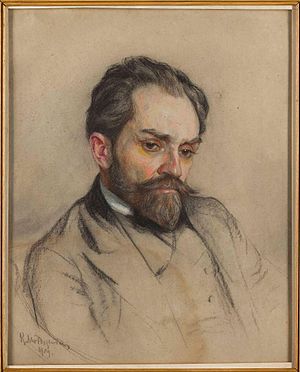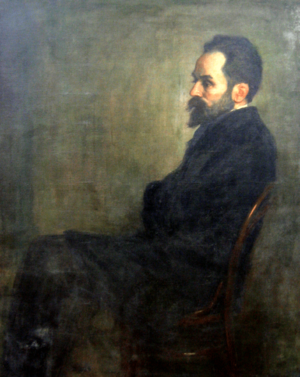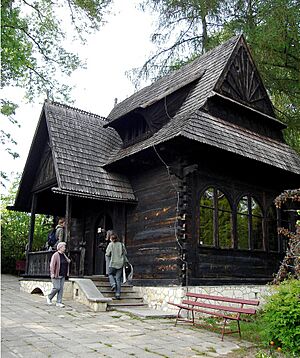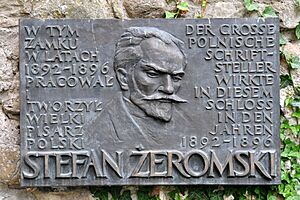Stefan Żeromski facts for kids
Quick facts for kids
Stefan Żeromski
|
|
|---|---|

Żeromski (pastel by Kazimierz Mordasewicz, 1909)
|
|
| Born | 14 October 1864 Strawczyn, Kingdom of Poland |
| Died | 20 November 1925 (aged 61) Warsaw, Poland |
| Pen name | Maurycy Zych, Józef Katerla, Stefan Iksmoreż |
| Occupation | Writer |
| Nationality | Polish |
| Notable works | Przedwiośnie Ludzie bezdomni Popioły Syzyfowe prace |
| Spouse | Anna Zawadzka Oktawia Radziwiłłowicz |
| Children | Monika Żeromska Adam Żeromski |
Stefan Żeromski (born October 14, 1864 – died November 20, 1925) was a famous Polish novelist and dramatist. He was part of a group of artists called the Young Poland movement. People often called him the "conscience of Polish literature" because his writings explored important social and moral issues.
He also used different names when he wrote, like Maurycy Zych, Józef Katerla, and Stefan Iksmoreż.
Żeromski was nominated four times for the important Nobel Prize in Literature.
Contents
A Look at Żeromski's Life
Stefan Żeromski was born on October 14, 1864. His birthplace was Strawczyn, a town near Kielce in Poland.
Early Life and Family
On September 2, 1892, he married Oktawia Rodkiewicz. They had met at a health spa in Nałęczów.
The couple then moved to Switzerland. From 1892 to 1896, Żeromski worked as a librarian. He worked at the Polish National Museum in Rapperswil.
Later, in 1913, Żeromski married the painter Anna Zawadzka. They had a daughter named Monika.
Recognition and Later Years
In 1924, Poland's President, Stanisław Wojciechowski, honored Żeromski. He gave him a special apartment in Warsaw's Royal Castle. This was a big recognition of his literary work.
In the same year, Żeromski was considered for the Nobel Prize in literature.
He passed away on November 20, 1925, in Warsaw.
Important Books and Stories
Stefan Żeromski wrote many well-known books and short stories. His works often talked about Polish history and society.
- Twilight (Zmierzch, short story, 1892)
- Ravens and Crows Will Peck Us to Pieces (Rozdziobią nas kruki, wrony, 1895)
- Doctor Peter (Doktor Piotr, 1895)
- The Labors of Sisyphus (Syzyfowe prace, 1898): This book is about how the Russian rulers tried to make Poles more like Russians in the 1800s and early 1900s.
- Homeless People (Ludzie bezdomni, 1899)
- Ashes (Popioły, 1904)
- Forest Echoes (Echa leśne, 1905)
- The Wages of Sin (Dzieje grzechu, 1908)
- Elegy for a Hetman (Duma o hetmanie, 1908)
- The Rose (Róża, 1909)
- Sułkowski (1910)
- The Faithful River (Wierna rzeka, 1912)
- The Charm of Life (Uroda życia, 1912)
- Struggles with Satan (Walka z szatanem, vols. 1-2, 1916; vol. 3, 1919)
- Wind from the Sea (Wiatr od morza, 1922)
- My Quail Has Fled (Uciekła mi przepióreczka, 1924)
- Seedtime (Przedwiośnie, 1924)
- Journals (Dzienniki, published after he died, 1953-1956)
Żeromski's books have been translated into many languages. For example, a Croatian scholar named Stjepan Musulin translated them into Croatian.
Żeromski's Books on Screen
Some of Żeromski's novels have been made into movies.
- Dzieje grzechu (A Story of Sin) was directed by Walerian Borowczyk.
- Popioły (Ashes) was directed by Andrzej Wajda.
- Przedwiośnie (The Spring to Come) was directed by Filip Bajon.
See also
 In Spanish: Stefan Żeromski para niños
In Spanish: Stefan Żeromski para niños
- Young Poland
- Republic of Zakopane
- List of Poles




